Review Article 
 Creative Commons, CC-BY
Creative Commons, CC-BY
Effect of Global Warming on Temperate Fruit Production in Japan and A Possible Countermeasure Using Bio-Stimulants
*Corresponding author: Mami Irie, Associate Professor at Tokyo University of Agriculture, Department of International Agricultural Development, 1-1-1 Sakuragaoka, Setagaya-ku, Tokyo 156-8502, Japan.
Received: July 30, 2024; Published: August 02, 2024
DOI: 10.34297/AJBSR.2024.23.003090
Introduction
It has passed long time since the “global warming” was alerted. Now a day, we could feel it by our own sense especially for these 3-4 years in Japan. In reality, according to the Japan Agriculture Daily, 20th Sep. 2020, the average temperature of several districts in Japan recorded 2-5 ℃ higher than usual years. Orchard owners are one of the most sensitive people to global warming because it might well affect their working calendar and income at last.
In case of cereals or vegetables which are grown annually, we can take several countermeasures, for example, to change the cultivars into heat tolerant ones. On the contrary, in case of perennial crops like fruits or industrial crops, it is difficult to transplant new varieties, because it sometimes forms brand production center and cultivation or breeding of heat tolerant varieties require so long time. In our opinion, we can use more bio-stimulants to cope with these problems derived from global warming.
Of course, we could use some phytohormones like ABA and/ or plant growth regulators to enhance heat tolerance temporarily, but dose-response curves are so sharp that we need precise experiments to search for the best timing and concentration, referring to local weathers and growth stages of the crops. In case of bio-stimulants, however, the effects might be mild with less concern on the adverse effects on the environment. The concept of bio-stimulants is not yet common, so we are trying to introduce some of them, showing some application examples. They are not the one so called agricultural chemicals which strictly require registration.
Adverse Effects of High Temperature on Apple Orchard in Nagano Prefecture
At first, we visited one apple orchard owner who has long grown apple and other fruits in Chikuma city, Nagano prefecture. Apple is one of the most sensitive fruits against heat since the pigmentation can be inhibited by high temperature. He indicated that the adverse effect of high temperature was outstanding judging from the phenomena as “early wake up of apple trees, which start water absorption even in the end of February, which usually happen in the midst of March in usual years, because dormancy might be deeper when they passed snow cold weathers”. The orchard owner could know the time of dormancy break of apple buds – if the trees are awake, the saw can be drawn very slowly and prudently. Branches awake could not be cut easily due to the higher percentage of water inside the trees. He continued to say “the apple trees which did not encounter the winter coldness, usually sleep shallowly and fail to prepare enough flower buds, resulting in less powerful flowers. Apple tree inclines to make flowers at the top of branches, where we could keep enough flower numbers even in warmer years. But the flower numbers in the middle of branches decline and there observed many clusters with only 3-4 flowers inside these years (normally 5 flowers are located). Such flowers could provide poorer pollen which leads to lower fruit-set that finally results in imperfect thickening.”
He also insisted that “higher temperatures enhance transpiration activity and it sometimes make short of water absorption from the roots, often leading to wilting and in severe case die-back of the leaves can be observed. In consequence, the photosynthetic activity declines and yield might be decreased due to the poor translocation of photo-assimilates into fruits”.
“In addition, activity of mites increases in accordance with higher temperatures, and it definitely requires adopting different kinds of mite killers in order to avoid resurgence”. High temperature induces not only the changes in fruit metabolism and quality, but also invites insects and diseases.
“There observed specific symptom called sun-burn, which was caused by direct sun-shine on the skin surface of fruits especially those located in southern west”. High temperature also inhibits color pigment accumulation, especially that of anthocyanin synthesis. When night temperature is high, photo-assimilates might be used by respiration rather than loaded to phloem to be distributed to fruit. This is the same phenomenon with red leaf formation in autumn. Diurnal temperature changes are necessary to contribute to the pigmentation. Aomori and Nagano prefectures have met such conditions to enhance color formation of apple ever since, but climate change affects Nagano prefecture in particular. The followings are the issues to be solved in future.
a) Deficiency of cold temperature in winter→no enough dormancy→ early wake up
b) Decrease in flower number
c) Low pollen germinability→low fruit set
d) Leaf transpiration > water absorption from roots→wilting
e) Increase in mites and pests
f) Severe sunlight→sun burn
g) Higher night temperature→insufficient translocation of photo- assimilates with poor anthocyanin accumulation.
In this review aricle, we are trying to explain on the countermeasure on sunburn and insufficient pigmentation, mainly on apple of Nagano prefecture, with some information of other fruits.
Adverse Effects of High Temperature
The picture below shows you sunburn of mandarin fruit (Citrus unshu) grown in Odawara, Kanagawa prefecture. Citrus family is rather tolerable to higher temperatures because they can be sometimes grown without irrigation even in summer season to increase sugar content in fruit. In 2020 summer, however, sunburn symptoms like in picture were often observed (Figure 1).
Sunburn was often found in branches at the top of the canopy, and it required pruning later. As a countermeasure, fruit located in upper parts might be pruned to leave all the fruit in lower parts. It also gives you an easy harvest works to pick the remaining fruit without using ladders. You should remark that the leaf-fruit ratio should be around 25:1 to promise well developed fruit.
The next two pictures show you a wilting of Japanese persimmon tree and sun-burnt persimmon fruits due to the very hot summer day in Hamamatsu area on 27th, Aug. 2020, when the Japanese highest temperature 41.1℃ was recorded. The leaves were wilting by continued transpiration in order to lower the leaf temperature by evapo-transpiration. This tree was fortunately rescued by quick irrigation right after this picture (Figure 2,3).
The below is the picture taken in Chikuma city, Nagano prefecture. The symptom in leaf die-back of grapes indicates the imbalanced water relations with higher transpiration against poor water absorption (Figure 4).
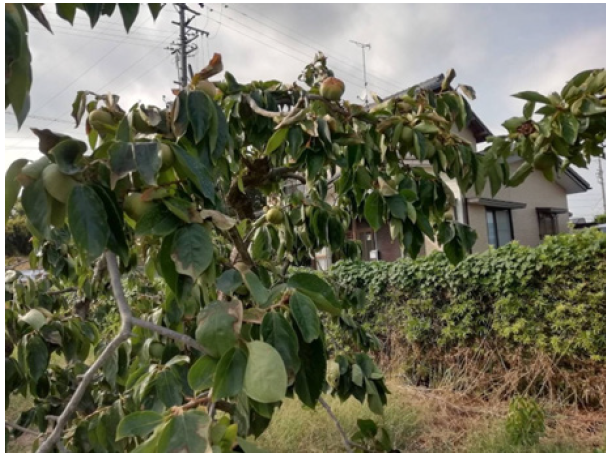
Figure 2: Wilting observed in Japanese persimmon leaves caused by high temperature, in Hamamatsu city, Shizuoka Prefecture.
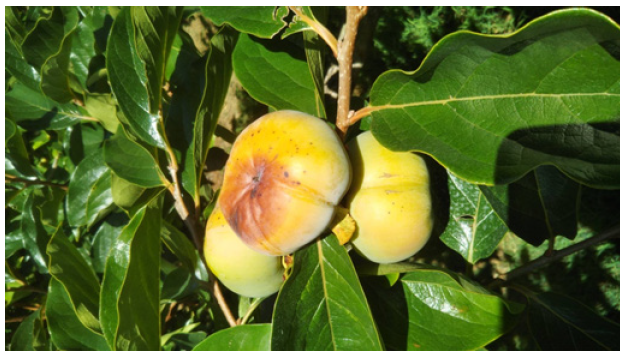
Figure 3: Sunburn observed in Japanese persimmon fruit caused by high temperature, in Hamamatsu city, Shizuoka Prefecture.
As for the apple pigmentation, let us briefly explain the physiological processes during fruit maturation. When you attach a paper on apple skin, the development of anthocyanin pigment might be suppressed under the paper. This phenomenon indicates the requirement of light for the formation of red pigment. If you cover the fruits with double paper bags, the chlorophyll on the fruit skin could be decomposed, and the contrast against red color becomes clearer later. Such dual processes, namely chlorophyll degradation and anthocyanin pigmentation are independently and simultaneously proceeded. Only after chlorophyll degradation completed, you can remove outer bag to promote anthocyanin pigmentation mildly. In case you remove both two bags at once, sunburn might happen. This is the reason we use double bagging to draw arts on the skin of apple fruit.
On the contrary, very hot summer like 2020, both processes of chlorophyll degradation and anthocyanin pigmentation were suppressed at the same time. The enzymes, namely chlorophyllase and Phenylalanine Ammonium-Lyase (PAL) are known to be activated by a phytohormone ethylene, which is an only and unique gaseous hormone. Thus, it means that in case we could control these processes by some bio-stimulants which promote ethylene release, we can contribute to improve apple color formation.
The significant effect of sucrose on apple pigment formation is well known. In case of hot summer, which makes apple tree to consume much sucrose for respiration, exogenous sucrose application might be one of the promising countermeasures to supplement anthocyanin accumulation of apple fruit.
We had checked the canopy temperatures of apple orchard in Chikuma city using ultrared thermometer, at 2 o’clock afternoon on a certain September day. The picture shows the 7 checking points in the orchard where temperatures of 4 directions (north, south, west, east) were measured. The results indicate the higher temperature at west and south directions; some shows higher than 40℃ (Figure 5).
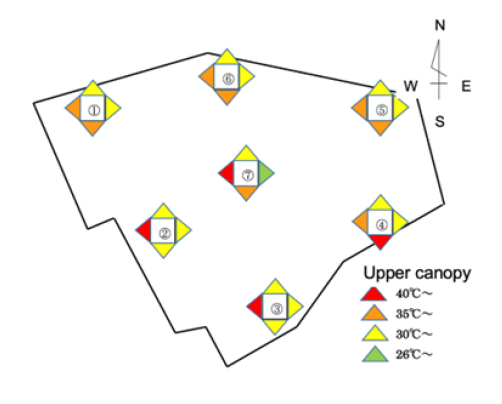
Figure 5: Canopy temperature of 4 directions of apple orchard in Chikuma city, Nagano prefecture, on 7th September 2020.
The following pictures show you the sunburn occurred in the same orchard. The surface temperatures of these apple fruit were higher than 40℃, and some cases it reached up to 45℃ (Figure 6).
These fruits soon turn their skin color into dark brown and de- cay process starts inside the flesh (Figure 7).
It is known that such sunburn phenomenon was considered to be caused by radical formation. We made clear the deep relationship between sunburn extent and superoxide radical formation indicating that the excess sunlight produces superoxide radicals which cause damages in cell membrane and/or enzymes activities, resulting sunburn.
Now we are trying to check the effects of the following bio-stimulants to prevent sunburn of apple fruit.
a) Methionine: promotion of ethylene formation
b) Vitamin C and tocopherol: radical scavenger
c) Glycerin: preventing sunburn and keep moisture on the skin
d) Cysteine and Histidine: protection of SH groups
e) Sucrose: promotion of anthocyanin formation
f) Proline: stress alleviation
Methionine might enhance the activity of phenylalanine ammonium lyase which plays an important role in changing phenylalanine into trans-cinnamic acid, a first key step of anthocyanin formation. Vitamin C (ascorbic acid: hydrophilic) and tocopherol (lipophilic) are to be added to scavenge radicals to prevent membrane damage. Cysteine and histidine could play some roles in preventing SH group modification. Sucrose could enhance anthocyanin biosynthesis in combination with proline which might induce stress tolerance of the apple tree and fruit.
Conclusion
Global warming might affect a variety of agricultural activities. To cope with such adverse effects, breeding heat tolerant varieties and/or other cultivation technique innovations should be necessary, as well as the development of new method of bio-stimulant utilization. Bio-stimulants are regarded as environmentally mild and no harmful for human health. The authors hope that the preliminary study shown here can be a material for the brainstorming of next generations.
Funding
None.
Acknowledgments
The authors are thankful to Mr. Takeshi Tobita and Mr. Kazuki Tobita (apple growers in Chikuma city, Nagano Prefecture), Mr. Fumitaka Akisawa (citrus grower in Odawara city, Kanagawa Prefecture), and Mr. Akira Adachi (persimmon grower in Hamamatsu city, Shizuoka Prefecture) for their kind cooperation during our interviews.
Conflict of Interest
None.


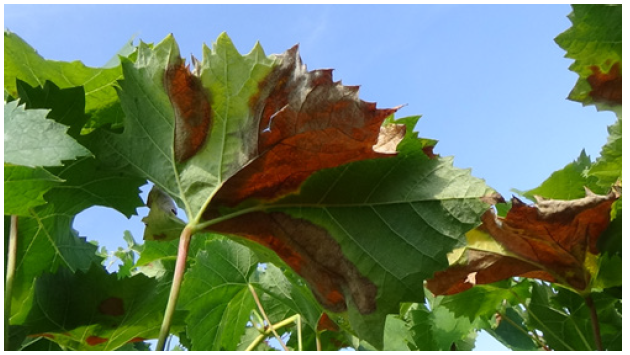
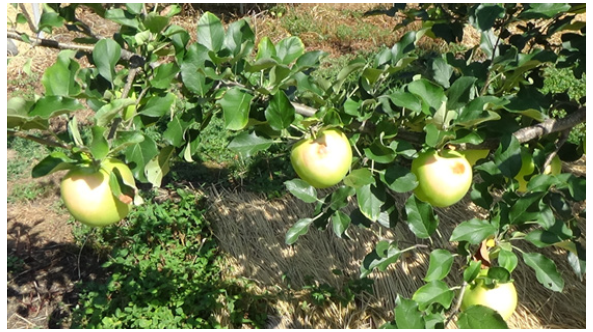
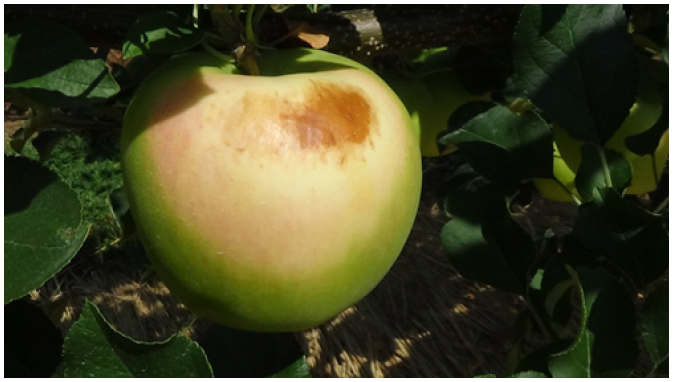


 We use cookies to ensure you get the best experience on our website.
We use cookies to ensure you get the best experience on our website.